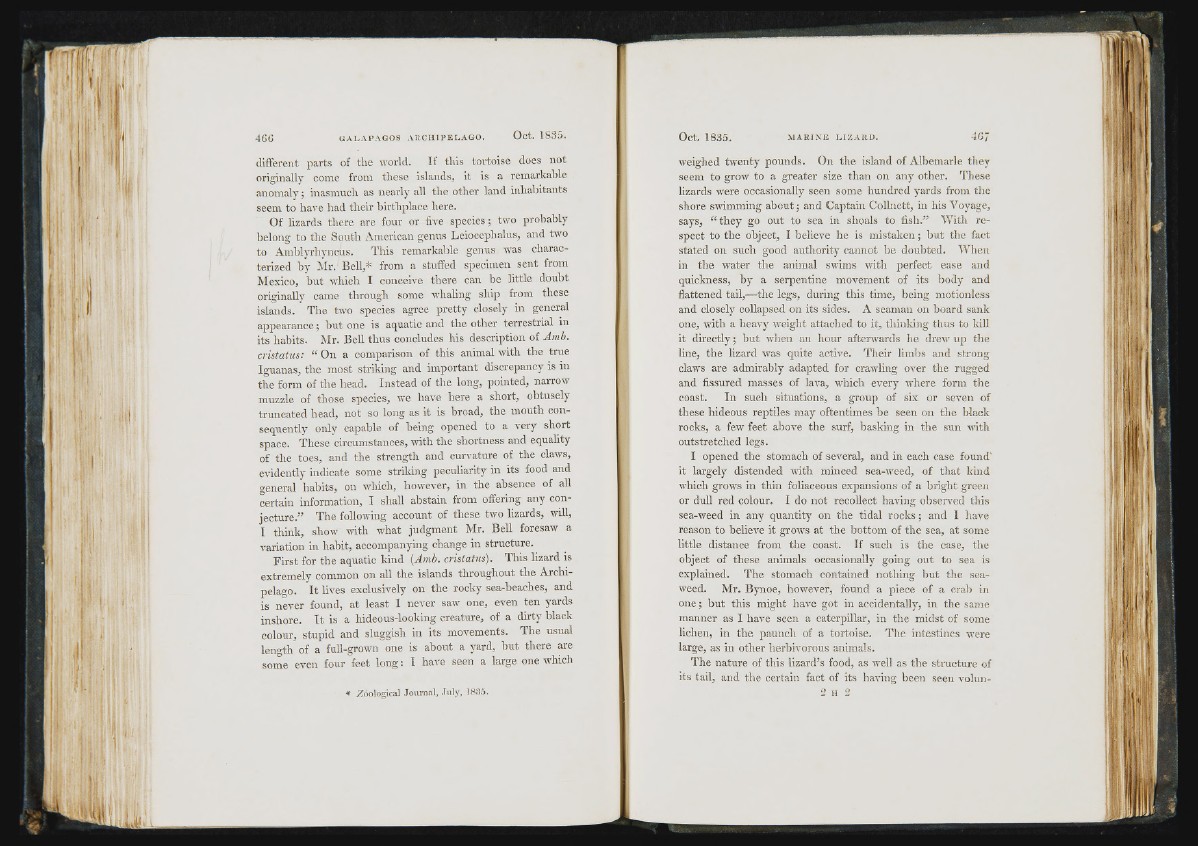
( ’ il different parts of the world. It this tortoise does not
originally come from these islands, it is a remarkable
anomaly; inasmuch as nearly all the other land inhabitants
seem to have had their birthplace here.
Of lizards there are four or five species; two probably
belong to the South American genus Leiocephalus, and two
to Amblvrhyncus. This remarkable genus was characterized
hy Mr. Bell,* from a stuffed specimen sent from
Mexico, hut which I conceive there can be little doubt
originally came through some whaling ship from these
islands. The two species agree pretty closely in general
appearance; but one is aquatic and the other terrestrial in
its habits. Mr. Bell thus concludes his description of Jmb.
cristatus: “ On a comparison of this animal with the true
Iguanas, the most striking and important discrepancy is in
the form of the head. Instead of the long, pointed, narrow
muzzle of those species, we have here a short, obtusely
truncated head, not so long as it is broad, the mouth consequently
only capable of being opened to a very short
space. These circumstances, with the shortness and equality
of the toes, and the strength and curvature of the claws,
evidently indicate some striking peculiarity in its food and
general habits, on which, however, in the absence of all
certain information, I shall abstain from offering any conjecture.”
The following account of these two lizards, will,
I think, show with what judgment Mr. Bell foresaw a
variation in habit, accompanying change in structure.
First for the aquatic kind {Amb. cristatus). This lizard is
extremely common on all the islands throughout the Archipelago.
It lives exclusively on the rocky sea-beaches, and
is never found, at least I never saw one, even ten yards
inshore. It is a hideous-looking creature, of a dirty black
colour, stupid and sluggish in its movements. The usual
length of a full-grown one is about a yard, but there are
soi^e even four feet long : I have seen a large one which
* Z o o lo g ic a l J o u rn a l, J u ly , 1835.
weighed twenty pounds. On the island of Albemarle they
seem to grow to a greater size than on any other. These
lizards were occasionally seen some hundred yards from the
shore swimming about; and Captain Colhiett, in his Voyage,
says, “ they go out to sea in shoals to fish.” With respect
to the object, I believe he is mistaken; but the fact
stated on such good authority cannot be doubted. When
in the water the animal swims with perfect ease and
quickness, by a serpentine movement of its body and
flattened tail,—the legs, during this time, being motionless
and closely collapsed on its sides. A seaman on board sank
one, with a heavy weight attached to it, thinking thus to kill
it directly; but when an hour afterwards he drew up the
line, the lizard was quite active. Their limbs and strong
claws are admirably adapted for crawling over the rugged
and fissured masses of lava, which every where form the
coast. In such situations, a group of six or seven of
these hideous reptiles may oftentimes be seen on the black
rocks, a few feet above the surf, basking in the sun with
outstretched legs.
I opened the stomach of several, and in each case found'
it largely distended with minced sea-weed, of that kind
which grows in thin foliaceous expansions of a bright green
or dull red colour. I do not recollect having observed this
sea-weed in any quantity on the tidal rocks; and I have
reason to believe it grows at the bottom of the sea, at some
little distance from the coast. If such is the case, the
object of these animals occasionally going out to sea is
explained. The stomach contained nothing bat the seaweed.
Mr. Bynoe, however, found a piece of a crali in
o ne ; but this might have got in accidentally, in the same
manner as I have seen a caterpillar, in the midst of some
lichen, in the paunch of a tortoise. The intestines were
large, as in other herbivorous animals.
The nature of this lizard’s food, as well as the structure of
its tail, and the certain fact of its having been seen volun